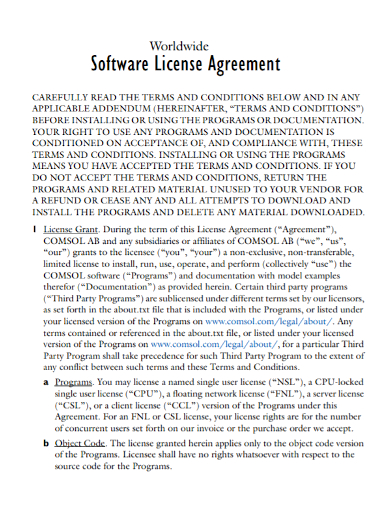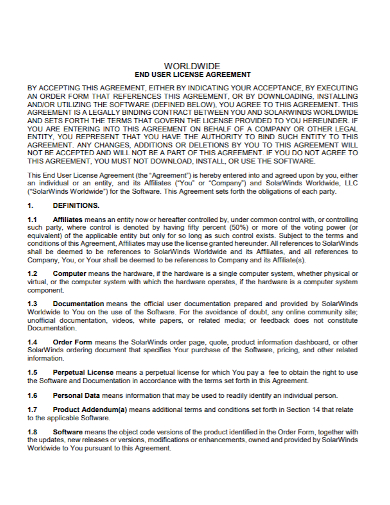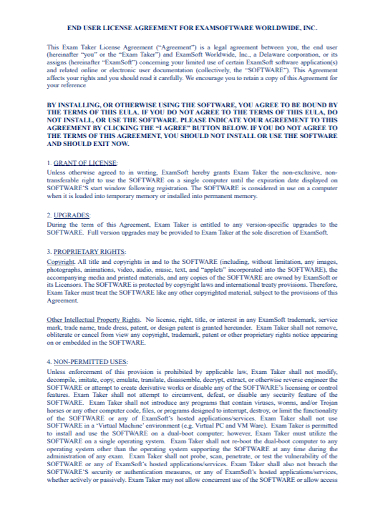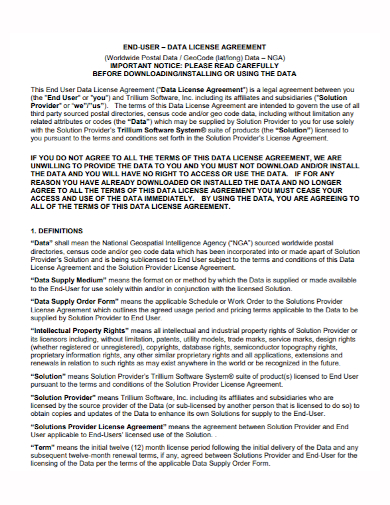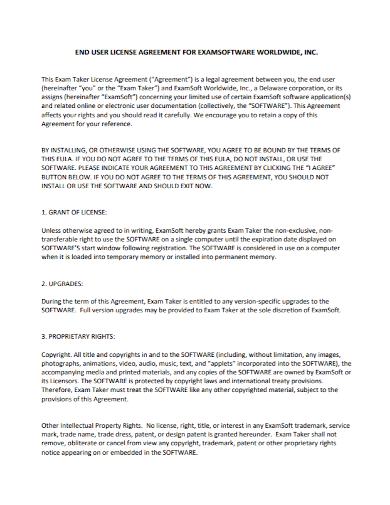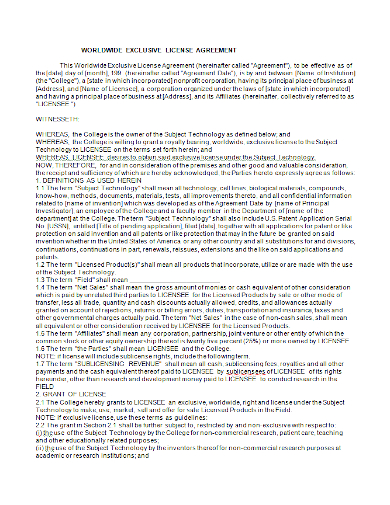Licensing agreement is a contractual relationship between two parties in which a licensee is granted by a licensor to use their company name, trademark, ability to produce and sell goods, and patented technology. In exchange for using their intellectual property, the licensor usually requires the licensee to pay an upfront fee or royalty fee. An international or worldwide license agreement is an important part of global businesses which enables a business to establish direct access to another target market.
6+ Worldwide License Agreement Samples
1. Worldwide License Agreement Template
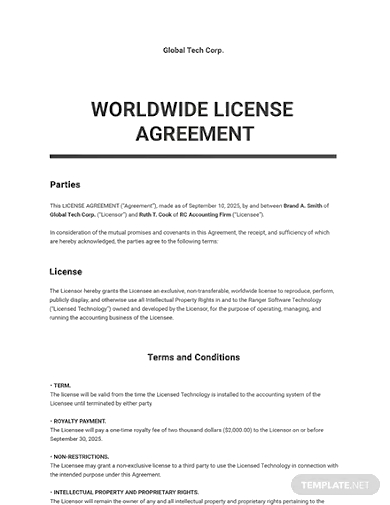
2. Worldwide Software License Agreement
3. Worldwide End User License Agreement
4. Worldwide End User Software License Agreement
5. Worldwide End User Data License Agreement
6. Worldwide End User Grant License Agreement
7. Worldwide Exclusive License Agreement
What is a Worldwide License Agreement?
A worldwide license agreement is a licensing transaction in which multiple agreements are made with a third party or third-party affiliates in countries such as the European market and North America. With this agreement, a company is allowed to utilize another company’s protected materials like designs, patents, trademarks, and other intellectual property. A worldwide license agreement also contains the terms and conditions that the licensee has to follow to continuously use the protected materials.
How to Write a Worldwide License Agreement?
Licensing agreements are contractual documents used by individuals or companies who own a patent on a piece of technology, a copyright on a photograph, a trademark on special images, or have ownership of other inventions or creative works. This document allows them to lay out the terms and conditions related to their intellectual property that a licensee should follow to ensure the protection and safety of the property like how it should be used, who owns it, the description of the property, and the term length that the licensee is allowed to use the intellectual property.
Step 1: Provide Information about the Parties Involved
The worldwide license agreement, like other contractual agreements, should contain information about the licensor and licensee, the type of intellectual property being licensed, where it will be used, when the agreement will end or be renewed, the purpose of the license agreement, and how much and when the licensee will pay for the license.
Step 2: Determine the type of Intellectual Property being Covered
The agreement should also determine the type of intellectual property it will be covering. These types of licenses include copyright, trademark, service mark, patent, know-how which refers to an expert skill or information, and trade secrets.
Step 3: Include Information about Agreement Fees and Royalties
There are several types of fees you can utilize to charge your intellectual property like issuance fee which is a fixed fee that a licensee must pay, renewal fee which is usually an annual fee paid to automatically renew the license, royalty payment for continuous use of the license, and milestone payment which is a fixed fee that a licensee pays if they accomplished a certain milestone.
Step 4: Add other Provisions that can be included in the Agreement
Other provisions you can include in the license agreement is the confidentiality, notice and markings, ownership of the intellectual property, protection, quality control, and sublicenses.
FAQs
What are the basic elements of a licensing agreement?
A licensing agreement contains basic elements that include the licensor, licensee, the intellectual property that is the subject of the license, the purpose of the licensee, the amount that a licensee will be paid to the licensor, and the term length they are allowed to use it.
What are the different types of licensing agreements?
The different types of licensing agreements are the exclusive license which grants the licensee exclusive rights on the intellectual property, non-exclusive license in which both the licensee and licensor can use the intellectual property, and sole license which grants exclusive rights to the licensee but also allows the licensor to keep their rights to use the property.
What is the use of a licensing agreement?
With a licensing agreement, an individual or company can use another person’s or company’s property like trademarks, copyrighted materials, and other intellectual properties. Common materials that have copyrights include music, videos, artwork, and films. A licensor grants a licensee permission to use their properties given that they are following the terms they had agreed upon.
An international or worldwide license agreement is a contract that is essential for building business relationships across different locations to acquire access to a larger market. It contains detailed information on what properties or materials the involved parties are authorized to use. This helps them prevent or resolve disputes that may occur in the future. The agreement also includes clauses such as contract length, dispute resolution, exclusivity, inventory management, sales requirements, oversight, quality control, payment terms, and more.
Related Posts
Teacher Agreement Contract Samples & Templates
Car Rental Agreement Samples & Templates
Vehicle Sales Agreement Samples & Templates
FREE 10+ Sample Indemnification Agreement Templates in PDF
FREE 10+ Fundraising Agreement Samples in MS Word | Pages | Google Docs | PDF
FREE 10+ Co-Branding Agreement Samples [ Partnership, License, Product ]
FREE 8+ Independent Agreement Templates in PDF | MS Word
FREE 11+ Sample Event Contract Agreement Templates in PDF | MS Word | Google Docs | Pages | Excel
FREE 26+ Investment Agreement Samples in PDF | MS Word | Google Docs | Pages
Land Purchase Agreement Samples & Templates
Sample Business Agreement between Two Parties
FREE 10+ Trial Agreement Samples In MS Word | Google Docs | Apple Pages | PDF
FREE 10+ Charter Agreement Samples In MS Word | Google Docs | Apple Pages | PDF
FREE 10+ Mentoring Agreement Samples In MS Word | Apple Pages | PDF
FREE 10+ Partner Agreement Samples In MS Word | Google Docs | Apple Pages | PDF

